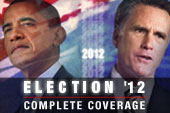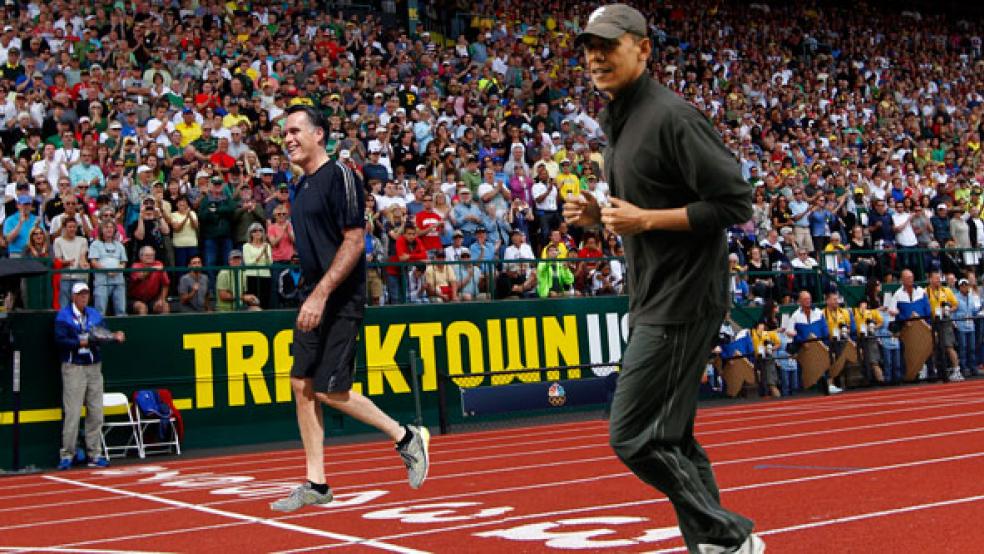The presidential campaign has entered its final stretch—which means no more debates but plenty of speeches and endless hours of TV ads await in the final sprint to the Nov. 6 election.

President Obama and Republican nominee Mitt Romney have wrestled each other into a statistical tie, according to most national polls. Those surveys contain multiple lessons about what will shape the final days of the race – especially in Ohio, Virginia and a handful of other key battleground states -- and potentially decide who occupies the White House.
Here are five of the most important lessons gleened from that data and reports from the field:
Saying You Have a Plan Is More Important than What Your Plan Says – President Obama published on Tuesday a 20-page booklet, “The New Economic Patriotism: A Plan for Jobs & Middle Class Security.”
The glossy is no “Dreams of My Father.” Spoiler alert: It repackages his existing promises to create factory jobs, cut oil imports in half, improve education, and reduce the projected budget deficits. But the compilation responds to Mitt Romney’s critique—and questions by the media, including The Fiscal Times, his rather vague agenda for a second-term. Its existence is more critical than its originality.
Similarly, Romney touts his own five-point plan for the economy, even though it does not—as currently explained—show how it’s possible to simultaneously cut taxes, increase military spending, create 12 million jobs in four years, and eventually produce a budget surplus.
“If we’ve got any math teachers out there, you can go ahead and look at this plan,” Obama said yesterday, while holding up his own booklet at a Florida event. “And you’ll see that the numbers work. I won’t be running the okey-doke on you.”
But unlike wonky journalists, voters tend not to dig through the economic proposals by presidential candidates. That’s why both Obama and Romney can gloss over the specifics of how they’d resurrect an economy that—while no longer in recession—is still in the doldrums.
“I put out a five-point plan that gets America 12 million jobs in four years,” Romney said at the Oct. 16 presidential debate on Long Island, just a few hours after the Washington Post’s Glenn Kessler debunked the math.
Voters feel pretty confident that they know what both candidates would do in the Oval Office, even when the ideas are either warmed-over or partisan boilerplate. Few details seem to be needed beyond Obama pledging to raise taxes on Americans making more than $250,000 a year in order to shrink the deficit in a “balanced” way, while Romney claims he would lower taxes and bolster spending on national security.
The NBC News/Wall Street Journal survey released Monday found that 57 percent of voters understood Romney’s plans, while 61 percent felt they had a sense of what Obama would do in a second term.
Real World Events Matter – Support for Obama’s foreign policy has been evaporating over the past month, a dramatic reversal of an advantage that previously looked insurmountable for Romney. Obama held a 15-point margin on global affairs in September, according to polling by the Pew Research Center. His lead narrowed to four points this month, 47 percent to 43 percent, Pew reported last week.
It remains to be seen whether the Monday night foreign policy debate will reverse the slide. But what appears to have led to the change was the death of the U.S. ambassador to Libya and three other Americans in a terrorist assault this past Sept. 11.
Those four murders undermined a credibility that Obama built with the raid killing Osama bin Laden, the withdrawal of combat troops from Iraq, and putting in place a 2014 exit plan from Afghanistan.
Plenty of other issues—such as China and Iran—have shaped public sentiment on international issues. However, a separate Pew survey showed a marked split with independent voters disapproving of how the administration handled the attack in Benghazi, Libya. It was not, as originally claimed, caused by a spontaneous protest against an anti-Muslim video produced in the U.S. Among independent voters who follow the news, the disapproval was 59 percent to 29 percent.
Demographics Are Destiny -- If the current trends continue, the election will highlight sharp political, gender and racial divides—such that neither candidate will be able to claim a resounding mandate.
White independent conservatives and white evangelical Christians, groups that were previously suspicious of the former Massachusetts governor during the GOP primaries, according to an analysis of the latest Wall Street Journal/NBC News poll, have abetted Romney’s surge in the polls.
The gap has widened to a point that it could cost Obama reelection. The nation’s first African-American president defeated Republican John McCain four years ago with about 43 percent of the white vote -- which in total makes up almost 70 percent of the electorate. Recent polls show that Obama’s support among whites has dropped dangerously to only 36 percent.
Obama’s hopes for reelection hinge on an eight-point advantage over Romney among women voters, a startling 45-point advantage among Hispanics, and an overwhelming majority of African-American voters. But Romney has chipped away at that critical edge Obama enjoys with women voters, as his message on the economy appears to be having a greater impact than the president highlighting his support for reproductive rights issues and equal pay.
It’s All About Turnout – Earlier in the election, some Republicans complained that the polls were skewed toward Obama because they were weighted more toward Democrats. The lesson here isn’t about conspiracy, but the turnout needed to drive enough supporters into the voting booth and secure victory.
This is why TV viewers get barraged with advertisements. It’s why Obama opened 122 local campaign headquarters in Ohio, compared to 40 for Romney in the Buckeye State. AFL-CIO president Richard Trumka blogged yesterday that the union will knock on 5.5 million doors and make 5.2 million phone calls before the election.
Consider the Fox News survey of 1,130 likely voters in Florida that was released last week. It found Romney was ahead 48 percent to 45 percent, almost the exact opposite of its results from last month.
Did Romney gain momentum from the president’s pathetic showing at their first Oct. 3 debate? Of course. But what also changed was voter identification. Between September and October, the share of self-identified Democrats fell to 40 percent from 42 percent. Republicans increased to 39 percent from 37 percent.
If Democrats vote at their September levels, the Fox News poll would instead show a dead heat of 46 percent to 46 percent. These polls are guides, not just forecasts.
Pivotal Moments Count the Most —Campaigns are often an endless loop of zingers and blathering about talking points, but then there are shocking moments that can dramatically transform the race. The opportunity for these moments becomes increasingly rare as the election nears, but the pressure involved in cementing a win means another trip-up could easily happen.
While historians no doubt will spent years analyzing key moments in the 2012 campaign, the four that stand out most deal with the vagaries of the unemployment numbers, Romney’s “47 percent” comment, the deadly attack on the U.S. consulate in Libya and the first of the three presidential debates.
A string of positive government employment reports at the start of the year helped Obama make the case that the economy was turning around. But by June the economy had increased payrolls by a measly 45,000-nowhere near what was needed to keep up with population growth—and the Romney campaign gained traction, while Obama stumbled.
Romney’s luck quickly soured, however, with the unearthing by Mother Jones magazine of a surreptitiously videotaped speech he gave to a group of fat cat donors in May.
For nearly a year, Romney had vigorously fended off the criticisms by Democrats and Republicans alike that he was essentially a super wealthy former businessman out of touch with average Americans, even as a slew of public statements, such as knowing the owners of NASCAR teams, indicated the stereotypes were somewhat accurate.
The videotape of Romney dissing the “47 percent” of Americans who don’t pay federal income taxes and are dependent on government programs validated that unflattering portrayal for many and nearly shattered any hope he had of overtaking Obama.
Obama enjoyed a substantial bump in the polls after a highly successful late summer Democratic national convention in Charlotte, N.C. But the deadly attack on the U.S. consulate in Benghazi, coming on the heels of anti-U.S. demonstrations throughout the Middle East, generated friction.
It was Obama’s miserable showing in the first of three presidential debates that ultimately set the course for the final days of the race. Romney came across as sharp and forceful, while Obama buried his arguments in awkward pauses and a passively aloof manner of speaking.
The popular blogger Andrew Sullivan summarized the showdown in a mid-debate tweet: “This is a rolling calamity for Obama. He's boring, abstract, and less human-seeming than Romney!”
The president put Romney on the defensive in the second and third debates. But polling suggests that the damage was already done, and that Obama’s forcefulness at best may have slowed Romney’s surge in the polls.





